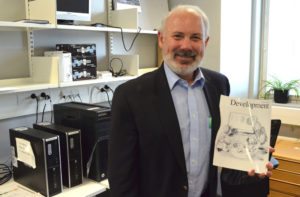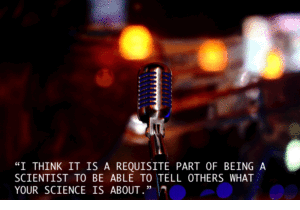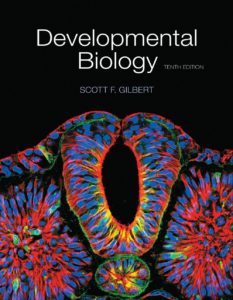We had the great pleasure to interview Scott Gilbert, the author of various textbooks such as ‘Developmental Biology’ and ‘Ecological Developmental Biology’. Scott Gilbert is a Professor of Biology (Emeritus) at Swarthmore College, where he has taught developmental genetics, embryology, and the history and critiques of biology. He is a Finland Distinguished Professor at the University of Helsinki, and an excellent science communicator. One of his research interests is how the turtle got its shell.

How important is science communication? Whose responsibility is it to communicate science?
SG: I think it is a requisite part of being a scientist to be able to tell others what your science is about. Why it is meaningful, why it is important! The importance does not have to be to cure any disease. It could be for curiosity, it could be for aesthetics. But I think that a scientist needs to be able to communicate to a larger audience. It is really important for a scientist to make his or her audience to know why what he or she is doing is important. One of the best explanations for this I have ever heard was by Leonard Bernstein, the music conductor. He was asked why he is playing Mahler so often with the New York Philharmonic Orchestra? His answer was: “Because I love Mahler. And I love my audience. So I want my audience to love Mahler as much as I do.” And I think for scientists it should be similar. If you love your science and you respect the public you should want the public to love the science as much as you do. Or at least to understand why you love it.

How did you end up writing text books?
SG: I ended up writing the Developmental Biology textbook because I was dissatisfied with what existed. You don’t write a textbook if you are happy with what is already there. I had accepted a position at Swarthmore college to teach developmental biology, but there was no book that I felt had the same vision that I had for developmental biology. And I was not the only one. Many young developmental biologists felt that textbooks did not capture what they felt developmental biology was. And this became so apparent that some publishers realised that they could do better, they could make more book sells if they had a book that people wanted to teach from. I was asked to meet Andy Sinauer, the publisher, and we talked and agreed on what a book should be. He said “Why don’t you try to write this? You have the background for it. You have the skills for it. See if you could write something. Send me the first 3 chapters and I send them out for review.” And so this is how the book got started: From dissatisfaction. I found out later that there were several people who were thinking of writing their own books. But when mine came out they felt that “Oh, I don’t need to write my own book. This is similar enough to the way I felt”. It was kind of a lateral inhibition.

How long did it take to write the book?
SG: It took five years to write the first edition. It would have taken four years but the person who is illustrating the book got ill. And so during that last year the experiments on the organizer came out where Gerhart demonstrated the Nieuwkoop center (Note: the organizer is defined as a region, or group of cells in an embryo that can both induce the fate of adjacent embryonic cells and establish the basic body plan. The Nieuwkoop center gives rise to the organizer in amphibians). And Kathryn Anderson showed that that maternal mRNA could direct development in Drosophila. These two important things in the molecularization of the field came out in 1984, and I was just able to put them in the book because this person got ill. So when the first edition of the book came out it already had this transition experiments, which was very important!
So the illness was a lucky incident in the end!
SG: Luck plays a huge role! I tell this to students that luck is a major part of life. It is like a surfer trying to get the perfect wave. You need the skills to ride the wave, but there has to be a wave and you have to be there at the right time, at the right place. You need the skills, no doubt about that! But you have to be lucky as well. Biologists, scientists don’t like luck. But it is there and I think I have been incredibly lucky.
“Luck plays a huge role!”
But writing a textbook is not so much about luck than about commitment!
SG: One of the reasons why I got into evolutionary developmental biology was because I had taken courses in the history of biology. It was just kind of a hobby. But when Evo-Devo (Evolutionary Developmental biology) started being formulated I knew all the work that Huxley and Owen and all these people did, and what we now call evolutionary developmental biology. I knew about Mecznikow, I knew about Kowalevsky. First, it did not seem that there would be any connection, but I actually was pre-adapted to evolutionary developmental biology. A lot of it is luck!
You spoke in front of the Dalai Lama at a symposium called “Bridging Science and Buddhism”. How was this initiated?
SG: It was initiated by the Dalai Lama 20 years ago. He changed the Geshe degree system, which is like the Buddhist PhD. He said that in order to get the Geshe degree you have to study Western science. And he also decided for the first time in Buddhist history that women could get the degree. So, the week that I was at this conference was the combination of both of these things. Monks had come from India to Emery University in Atlanta, Georgia, to learn science and then go back to teach science to their fellow monks. And the first women who were getting the Geshe degree were being graduated at that weekend! This was the first time that the monks who had learned science, an international group of scientists and the Dalai Lama were sitting at the same table. For me it was a huge honor. For the monks it was the combination of billions of years of Karma to reach that point. So, again, for me this was luck. For the monks luck had nothing to do with it; this was the Karma consequence. It was absolutely fascinating.
So for Buddhists Western science is not contradictory with their belief?
SG: They believe that Buddhism is many things. It is a religion, a way of living your life, but it is also a science. What I was able to talk about was a very important notion in Buddhism which is called dependent co-origination. Nothing emerges by itself, everything emerges by interaction and interpenetration with other things. And so I talked about the interactions between the sperm and the egg; that the egg in the female reproductive tract mature the sperm so that the sperm could then mature the egg. There is this mutual interaction. I talked about organ formation, where like in the eye the presumptive neural retina and the presumptive lens interact with each other in order to form each other, neither forms independently. So I was talking about body formation as a subset of their philosophy of dependent co-origination. In the sense of saying ‚You don’t have to fear this part of biology. It is something that you have talked about for thousand years.‘ They do have other things that are not this easy. For instance, the buddhists have a very difficult time believing that plants are living. Plants don’t move and besides you don’t eat living things! So not all is easy, but I think the Dalai Lama is very much in favour of good science. He not only initiated this program, but he told me after my lecture that what interests him is how the mammalian brain arose from the reptile brain and how the human brain arose from the mammalian brain. So he not only accepts evolution, he is interested in the mechanisms!
One last question – Do you think that we can remake dinosaurs?
SG (laughs): I don’t think that it is going to be all that difficult. Given that birds are probably dinosaurs, they are doing a very good job of evolving. It is a matter of cell death. The differences in dinosaurs and birds involve the tail; birds don’t have the beautiful tail that dinosaurs have. And birds don‘t have teeth. So I think in the near future we will be able to remake dinosaurs, yes.
Are you wondering what Scott Gilbert is holding in his hand? It is an artwork of one of his students, Roland Zimm, which made it on the cover of the Development journal.
Interviewed by Petra Tauscher